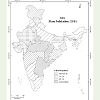Research Article
Slums in India: Results from Census,2011
Parveen Kumar*
*Assistant Professor, Department of Geography, K.L.P. College, Rewari, Haryana, India
Corresponding author: Parveen Kumar, Assistant Professor, Department of Geography, K.L.P. College, Rewari, Haryana,India, Tel: 9812953325; E-mail: parveenkumard99@gmail.com
Citation: Kumar P. Rain Water Harvesting and Artificial recharge in Haryana. J Environ Soc Sci. 2016;3(1): 124.
Copyright © 2016 Kumar P, et al. This is an open access article distributed under the Creative Commons Attribution License, which permits unrestricted use, distribution, and reproduction in any medium, provided the original work is properly cited.
Journal of Environmental and Social Sciences | Volume: 3, Issue: 1
Submission: 15/02/2016; Accepted: 27/02/2016; Published: 05/03/2016
Abstract
An increasing pace of urbanization in India after economic liberalization has pulled the migration from villages to towns/cities of India. These migrated people get some lucrative employment but face the problem of shelter as city system hardly allows them to have good shelter. As a result, these low income migrants have settled in pockets of city known as slums. This leads to the degradation of urban environmental and sustainable development. The presentstudy examines the magnitude of the slums in towns/cities of India using most recent census 2011 data. 65.5 million Peoples are living in slums in different size class of towns/cities of India. A popular view that the larger cities are marked by higher incident of slum than the smaller one is not authenticating by census 2011 data. Small towns with a population of less than 20,000 and medium towns with a population of 20,000 to 1,00000 have recorded 27.2% and 24.3% respectively.
Keywords: Slum; Urban areas; Census; Urbanization
Introduction
The rapid growth of urban population poses serious challenges in terms of provision of basic minimum services. Slums are an outcome of an imbalance in urban growth. The appearance of slums may be seen as a by-product in the process of urbanization in a developing country like India [1]. Poorly managed urban growth can thus lead to deteriorating health and environmental conditions, with serious implications for national government stability and international security [2]. Slums and squatter are considered as problem areas for urban development in third world countries. They are illegally occupied houses, creating a nuisance of environmental pollution and degradation of living conditions. Slums are the marginal areas of cities where the facilities are poor, people are illiterate, drinking water supply is miserable. Slum dwelling signifies as a common phenomenon of degraded life of urban dwelling itself. A slum represents a microhabitat institute that exists within a larger framework of urban built up space [3].
Slums have risen dramatically since 1947. There were main two reasons for slum development. One is Partition of India and the other is Industrial revolution after independence. Before 1950 slums were predominantly found around the mills, factories etc. They were mostly industrial workers in one room tenements [4]. Recently, Indian towns/cities have witnessed a significant increase in their development activities in the form of renewed urban planning and construction, establishment of industries and trade, expansion in transport and communication system, availability of their infrastructure facilities in post-independence era. Urban congestion, tremendous migration of labour force both skilled and unskilled, non-availability of housing infrastructure has lead to occurrence of slums and reflects the deteriorating quality of life in urban areas[5].
Census slums have been earmarked in all the statutory towns irrespective of their population size based on the same definition as in 2001 [6]. Three types of slums have been defined in Census, namely, Notified, Recognized and Identified; (i) All notified areas in a town or city notified as ‘Slum’ by State, Union territories Administration or Local Government under any Act including a ‘Slum Act’ may be considered as Notified slums (ii) All areas recognized as ‘Slum’ by State, Union territories Administration or Local Government, Housing and Slum Boards, which may have not been formally notified as slum under any act may be considered as Recognized slums (iii) A compact area of at least 300 population or about 60-70 households of poorly built congested tenements, in unhygienic environment usually with inadequate infrastructure and lacking in proper sanitary and drinking water facilities. UN Habitat define that a slum is an area that combines to various extents the following characteristics; inadequate access to safe water, inadequate access to sanitation and other infrastructure, poor structural quality of housing, overcrowding and insecure residential status [7].
Slums in towns/cities in India in 2011
The 21st century has witnessed a rapid growth of urban population coupled with incommensurate development of social facilities which has resulted in the creation of slums and associated problems of an alarming magnitude. Owing to lack of employment and suitable jobs in the countryside, people from rural areas migrate to the towns/ cities. In cities they obtain jobs, but their income hardly allows them to have good accommodation or neighborhood. Hence they occupy vacant land or try to adjust themselves in the existing slums. This results into a growth of slums and squatter settlements in most of the cities and towns of the country. In India, slums are found in all the cities, large and small, old or new, unplanned or planned (Figure 1) [5].
Slum demography had been presented on the basis of actual count in census 2011. The slum population was reported from 31 states/union territories in India. Four states/union territories namely, Manipur, Dadra and Nagar Haveli, Daman & Diu and Lakshadweep did not report any slum population in their cities/towns. 2613 towns reported slum population out of 4041 statutory towns. In 2001, 42.6 million populations were lived in slums in India which increased to 65.5 million by 2011. This constituted 17.4% of the urban population of the states/uts in 2011. The distribution of slum towns across the states and union territories was not uniform in India (Table 1).
Ten larger states enumerated more than 100 slums towns including Tamil Nadu (507), Madhya Pradesh (303), Uttar Pradesh (293), Karnataka (206), Maharashtra (189), Andhra Pradesh (125), West Bengal (122), Rajasthan (107) and Gujarat (103). These larger nine states include 1955 slum towns which accommodate more than 81% of the total slum population. On the other hand 9 small states and union territories include Nagaland, Sikkim, Pondicherry, Meghalaya Arunachal Pradesh, Goa, Mizoram, Chandigarh, Andaman and Nicobar had reported only 47 slum towns which share only 0.6% of the total slum population. In absolute terms, Maharashtra accounted for 11.8 million slum population which is 18.1% of the total slum population of the country. It was followed by Andhra Pradesh (10.2 million), West Bengal (6.4 million) and Uttar Pradesh (6.2 million). Nine states namely; Andhra Pradesh, Chhattisgarh, Madhya Pradesh, Maharashtra, Odisha, West Bengal, Sikkim, Jammu & Kashmir and Haryana had shown high percentage of slum population than the national average. Andhra Pradesh, Chhattisgarh, Haryana, Jammu& Kashmir, Madhya Pradesh, Maharashtra, Odisha, Sikkim and West Bengal have recorded high slum concentration than urban concentration high incidence of slums in comparison to level of urbanization where remaining states have reverse situation. A common perception that the larger cities are marked by higher incident of slum than the smaller one is not validated by census data. The proportion of slums was reported 27.2% in the case of small towns in comparison to 24.3% percent in medium towns.
Urbanization, industrialization and higher productivity in the secondary/tertiary sector against primary sector makes cities and towns centers of economic growth and jobs. Cities act as beacons for the rural population as they represent a higher standard of living and offer opportunities to people not available in rural areas. This results in large scale migration from rural to urban areas. Negative consequences of urban pull results in upcoming of slums characterized by housing shortage and critical inadequacies in public utilities, overcrowding, unhygienic conditions, etc. [6].
Conclusion
Growing pace of urbanization and the lack of affordable housing have resulted in growth of slums in urban India. They are found in all the cities, large and small, old or new, unplanned or planned. The prevalence of slums varies radically across towns/cities of India. In 2011, 65.5 million or 22.5% population lived in slums which are distributed among 2613 towns/cities. The distribution of slum towns across the states and union territories is not uniform in India. Indian 9 larger states namely; Tamil Nadu, Madhya Pradesh, Uttar Pradesh, Karnataka, Maharashtra, Andhra Pradesh, West Bengal, Rajasthan and Gujarat enumerated more than 81% slum population and 1955 slum town. On the other hand 9 small states/union territories include Nagaland, Sikkim, Pondicherry, Meghalaya Arunachal Pradesh, Goa, Mizoram, Chandigarh, Andaman and Nicobar had reported only 47 slum towns, share only 0.6% of the total slum population. Thus, high positive correlation exist between urban and slum concentration in Indian states. The ever-increasing slum population is a continuous phenomenon in towns/cities, but providing good facilities at the rate of their growth will definitely benefit all the slum dwellers. Abovediscussion which highlights the slum condition argue that there is an urgent need to tackle this situation for long term sustainable development as well as for city prosperity.
References
- Goswami S, Manna S (2013) Urban poor living in slums: A case study of Raipur city in India. Global J Hum Social Sci Res 13: 15-22.
- International Housing Coalition (2008) Multilateral and bilateral funding of housing and slum upgrading development in developing countries. Washington DC, pp. 1-11.
- Bala R, Kumar S (2013) Society, culture and economy of Indian slums: A critical perspective. Vignettes Res 1: 66-74.
- Bandyopadhyay A, Agrawal V (2013) Slums in India: From past to present. Int Refereed J Eng Sci 2: 55-59.
- Kumar J (2014) Million cities in India a geographic analysis of population characteristics, Maharshi Dayanand University, pp. 169.
- Census of India (2011) Primary census abstract for slum. Office of the Registrar General & Census Commissioner, India.
- UN Habitat Report (2003) Improving the lives of 100 million slum dwellers: Guide to monitoring target 11. GUO, pp. 15.


